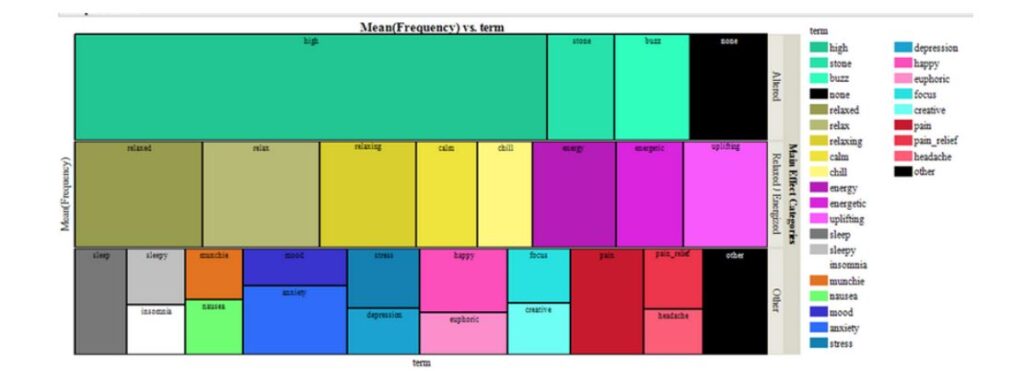THC and the Cannabis Mind Initiative
For too long, societies worldwide have prohibited Cannabis, a historically useful and valuable commodity. The predominant concern has been Cannabis delta-9-tetrahydrocannabinol (THC) content and its psychoactive effects. How does THC affect mental states? Is it beneficial? What are its liability concerns?CESC’s Cannabis Mind Initiative focuses on the psychoactive or intoxicating effects of Type I (THC dominant) Cannabis and its subtypes of varying potencies.
Cannabis typically contains one of two dominant phytocannabinoids, THCA or cannabidiolic acid (CBDA), and several combinations of other active ingredients. Consumers might inhale, apply, or ingest a product without apparent psychoactivity. However, it is the use of THC (derived from its THCA precursor) in products that most often leads to intoxicating states. THC’s psychoactive effects are mostly attributed to its activity on CNR1 (CB1), a prevalent G-coupled protein receptor in the brain. THC consumption may cause adverse effects; however, it also leads to meaningful subjective experiences. Despite a diverse and rich potential for Cannabis in the marketplace, THC is the elephant in the room. CESC’s study of THC-dominant Cannabis addresses its psychoactive and intoxicating effects.
In the past decade, we have seen unprecedented shifts in the availability of Cannabis. Increased access to Cannabis has been associated with an increase in high-potency THC products. From 1995 to 2014, THC potency tripled (4%-12%) in confiscated Cannabis flowers. Today, markets sell Cannabis flowers with 20% or more THC content. Extracted and concentrated oil products have potencies of 50-80% THC. Jurisdictions that have tried to prohibit D-9 THC see legal hemp products converted to other isomers of THC as companies work around regulations to offer a product with more psychoactivity.
Americans have a love-hate relationship with Cannabis. Harry J Anslinger, head of the US Treasury Department’s Narcotics Bureau, wrote his opinion in a 1937 article titled Marijuana, Assassin of Youth. “How many murders, suicides, robberies, criminal assaults, holdups, burglaries, and deeds of maniacal insanity it causes each year can only be conjectured.” The ludicrous notion that a plant could initiate such behavior had been popularized in a movie called Reefer Madness. Relative to the history of worldwide use, Anslinger’s perspective didn’t last long. By the 1960s, Anslinger had already conceded that the criminal penalties in force for Cannabis use were too severe. In 1967, mainstream voices of Life, Newsweek, and Look magazines questioned why the plant was illegal at all. By 1996, California had legalized Cannabis use for medicinal purposes through a proposition titled The Compassionate Use Act.
Contrasting perceptions and opposing effects are a hallmark of Type I Cannabis. The relaxing and euphoric effects are contradicted by concerns of anxiety and psychosis. It’s well understood that acute psychosis from THC can be debilitating, especially when unexpected. Dr. Nora Volkow, Director of the National Institute of Drug Abuse, notes that high-potency Cannabis.
products are associated with acute psychosis. However, intentional Cannabis experiences with appropriate doses of THC can also be used as therapy. The hypothesis is that THC may help expand the walls of perception and engender psychological flexibility, which leads to improved mental health conditions.
In a Natural Language Processing analysis of open-sourced reviews by respondents that used Type I Cannabis flowers, CESC identified commonly used words. These descriptors are group into three categories; states of altered consciousness (high, stoned, buzzed), a relaxed-energetic dichotomy, and a broad range of psychosomatic states. We anticipate that this categorization scheme will facilitate correlation with underlying pharmacologic mechanisms.

The frequency of descriptors maps subjective states of the “Cannabis Mind”. The results depict a range of effects describing a more complex experience than acute psychosis or the anticipated ‘high”.
With access to a Northern California community of 2,000 active users, CESC investigates the risk factors and therapeutic benefits of Type I Cannabis use. Data is gathered on the acute and chronic effects of Cannabis use. Longitudinal observations track the health and wellness endpoints of Cannabis users. Quantitative EEG analysis provides an objective biomarker in comparisons of subjective mood and consciousness scales. Our community serves as a model in our investigations of the “Cannabis Mind.”
The CESC is a non-profit organization that relies on community support for its ongoing investigations.
DONATE to Cannabis Science
For more information visit the CESC at www.thecesc.org.


